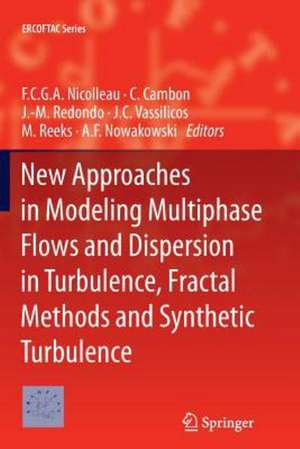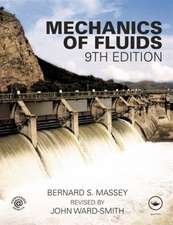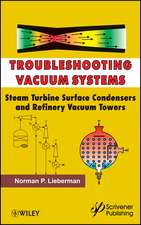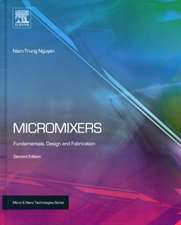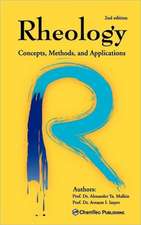New Approaches in Modeling Multiphase Flows and Dispersion in Turbulence, Fractal Methods and Synthetic Turbulence: ERCOFTAC Series, cartea 18
Editat de F.C.G.A. Nicolleau, C. Cambon, J.-M. Redondo, J. C. Vassilicos, M. Reeks, A.F. Nowakowskien Limba Engleză Paperback – 29 noi 2013
This volume investigates the use of Kinematic Simulation (KS) and other synthetic turbulence models for the particular application to environmental flows.
This volume offers the best syntheses on the research status in KS, which is widely used in various domains, including Lagrangian aspects in turbulence mixing/stirring, particle dispersion/clustering, and last but not least, aeroacoustics. Flow realizations with complete spatial, and sometime spatio-temporal, dependency, are generated via superposition of random modes (mostly spatial, and sometime spatial and temporal, Fourier modes), with prescribed constraints such as: strict incompressibility (divergence-free velocity field at each point), high Reynolds energy spectrum. Recent improvements consisted in incorporating linear dynamics, for instance in rotating and/or stably-stratified flows, with possible easy generalization to MHD flows, and perhaps to plasmas. KS for channel flows have also been validated. However, the absence of "sweeping effects" in present conventional KS versions is identified as a major drawback in very different applications: inertial particle clustering as well as in aeroacoustics. Nevertheless, this issue was addressed in some reference papers, and merits to be revisited in the light of new studies in progress.
| Toate formatele și edițiile | Preț | Express |
|---|---|---|
| Paperback (1) | 634.18 lei 6-8 săpt. | |
| SPRINGER NETHERLANDS – 29 noi 2013 | 634.18 lei 6-8 săpt. | |
| Hardback (1) | 640.24 lei 6-8 săpt. | |
| SPRINGER NETHERLANDS – 29 oct 2011 | 640.24 lei 6-8 săpt. |
Din seria ERCOFTAC Series
- 18%
 Preț: 1568.47 lei
Preț: 1568.47 lei - 18%
 Preț: 948.29 lei
Preț: 948.29 lei - 18%
 Preț: 1854.80 lei
Preț: 1854.80 lei - 18%
 Preț: 959.36 lei
Preț: 959.36 lei - 18%
 Preț: 955.70 lei
Preț: 955.70 lei - 18%
 Preț: 1831.27 lei
Preț: 1831.27 lei - 18%
 Preț: 953.52 lei
Preț: 953.52 lei - 20%
 Preț: 1280.03 lei
Preț: 1280.03 lei - 18%
 Preț: 1224.06 lei
Preț: 1224.06 lei - 18%
 Preț: 1216.48 lei
Preț: 1216.48 lei - 18%
 Preț: 944.51 lei
Preț: 944.51 lei - 18%
 Preț: 1227.36 lei
Preț: 1227.36 lei - 18%
 Preț: 1237.91 lei
Preț: 1237.91 lei - 20%
 Preț: 573.08 lei
Preț: 573.08 lei - 24%
 Preț: 1068.43 lei
Preț: 1068.43 lei - 24%
 Preț: 784.73 lei
Preț: 784.73 lei - 18%
 Preț: 955.25 lei
Preț: 955.25 lei - 18%
 Preț: 939.62 lei
Preț: 939.62 lei - 24%
 Preț: 892.07 lei
Preț: 892.07 lei -
 Preț: 387.96 lei
Preț: 387.96 lei - 18%
 Preț: 1391.21 lei
Preț: 1391.21 lei - 18%
 Preț: 1224.68 lei
Preț: 1224.68 lei -
 Preț: 396.62 lei
Preț: 396.62 lei - 18%
 Preț: 1234.94 lei
Preț: 1234.94 lei - 18%
 Preț: 1230.66 lei
Preț: 1230.66 lei - 18%
 Preț: 1228.62 lei
Preț: 1228.62 lei - 18%
 Preț: 1248.68 lei
Preț: 1248.68 lei
Preț: 634.18 lei
Preț vechi: 746.09 lei
-15% Nou
Puncte Express: 951
Preț estimativ în valută:
121.37€ • 126.24$ • 100.19£
121.37€ • 126.24$ • 100.19£
Carte tipărită la comandă
Livrare economică 14-28 aprilie
Preluare comenzi: 021 569.72.76
Specificații
ISBN-13: 9789400736948
ISBN-10: 9400736940
Pagini: 168
Ilustrații: XIV, 154 p.
Dimensiuni: 155 x 235 x 9 mm
Greutate: 0.25 kg
Ediția:2012
Editura: SPRINGER NETHERLANDS
Colecția Springer
Seria ERCOFTAC Series
Locul publicării:Dordrecht, Netherlands
ISBN-10: 9400736940
Pagini: 168
Ilustrații: XIV, 154 p.
Dimensiuni: 155 x 235 x 9 mm
Greutate: 0.25 kg
Ediția:2012
Editura: SPRINGER NETHERLANDS
Colecția Springer
Seria ERCOFTAC Series
Locul publicării:Dordrecht, Netherlands
Public țintă
ResearchCuprins
The impact of Kinematic Simulations on quantum turbulence theory, by Demosthenes Kivotides.- 1 Introduction.- 2 Mathematical model;3 Results.- 4 Conclusion.- References.- Detached Eddy Simulation for turbulent flows in a pipe with a snowflake fractal orifice, by H. W. Zheng, F. C. G. A. Nicolleau and N. Qin.- 1 Introduction - motivation.- 2 Governing equations;3 Numerical discretization.- 4 Results.- 5 Conclusions.- References.- KS input spectrum, some fundamental works on the vibration spectrum of a self-similar linear chain, by T. M. Michelitsch, F. C. G. A. Nicolleau, A. F. Nowakowski and S. Derogar.- 1 Introduction;1.1 Input spectrum in the Kinematic simulation technique.- 1.2 Richardson’s locality-in-scale hypothesis.- 2 Experimental studies of fractal generated turbulence.- 3 Fundamental modelling;4 Spectral Graphs for self-similar linear chains.- 5 Construction of self-similar functions and linear operators.- 5.1 Construction of self-similar functions.- 5.2 A self-similar analogue to the Laplace operator.- 5.3 Continuum approximation - link to fractional integrals.- 6 The physical chain model.- 7 Conclusions.- References.- Can Kinematic Simulation predict Richardson’s regime? , by F. C. G. A. Nicolleau and A. Abou El-Azm Aly.- 1 Introduction.- 1.1 The two-particle dispersion problem.- 1.2 Observation of the Richardson law.- 2 Kinematic simulation.- 2.1 Kinematic simulation technique.- 2.2 Kinematic Simulation’s predictions of Richardson’s law.- 2.3 The KS method for isotropic turbulence.- 2.4 The Eulerian field time dependence.- 3 KS and Richardson Regime Validation.- 3.1 Particle pair diffusivity.- 3.2 Sensitivity to the energy spectrum power law.- 3.3 Effect of varying the unsteadiness parameter on the Validity of Richardson Regime.- 4 Conclusion.- References.- Incorporating linear dynamics and strong anisotropy in KS. Application to diffusion in rotating, stratified, MHD turbulence, and to aeroacoustics, by C. Cambon,F. S. Godeferd and B. Favier.- 1 KS for homogeneous isotropic turbulence. What remains to be done ?.- 1.1 Is the randomization process optimal?.- 1.2 Are the temporal random frequencies really random variables ?.- 2 Incorporating linear dynamics in KS. Application to rotatin and/or stratified flows.- 2.1 Analogy with the Rapid Distortion Theory.- 2.2 The role of inertial waves.- 2.3 Stable stratification with or without rotation.- 3 The linear dynamics of MHD turbulence.- 3.1 Basic equations.- coexistence of waves with anisotropic ohmic dissipation.- 3.2 Preliminary MHD results with and without rotation.- 4 Accounting for strong anisotropy.- 4.1 Anisotropy created by linear mechanisms from isotropic initial data.- 4.2 Anisotropic initialization, link to ‘structures’.- 4.3 Some applications.- 5 Application to aeroacoustics in turbulence with and without rotation.- 5.1 Isotropic turbulence.- 5.2 Rotating turbulence.- 6 Conclusions and perspectives.- Appendices.- References.- Advances in Particle Representation Modeling of homogeneous turbulence. From the linear PRM version to the interacting viscoelastic IPRM , by S.C. Kassinos and E. Akylas.- 1 Introduction.- 2 The RDT formulation.- 3 The Structure Tensors.- 4 Particle Representation of the RDT of Homogeneous Turbulence.- 4.1 Particle Properties.- 4.2 Vector Identities of the Particle Properties.- 4.3 Evolution Equations of the Particle Properties.- 4.4 Representation of the One Point Statistics.- 5 The Interacting Particle Representation Model.- 5.1 Formulation of the IPRM.- 5.2 Evaluation of the IPRM.- 6 Summary and Conclusions.- References.- Oscillation-free Adaptive Simulation of Compressible Two-fluid Flows with Different Types of Equation of State, by H. W. Zheng, C. Shu, Y. T. Chew, and N. Qin.- 1 Introduction.- 2 Compressible Two-fluid Flows.- 2.1 Modelling with general form of equation of state.- 2.2 Oscillation-free analysis.- 3 Discretization on quadrilateral-cell based adaptive mesh.- 4 Results.- 4.1Interface translation problem.- 4.2 Bubble-shock interaction.- 5 Conclusions.- References.- Computing the evolution of interfaces using multi-component flow equations, by Fatma Ghangir and Andrzej F. Nowakowski.- 1 Introduction.- 2 The parent flow model.- 3 The hyperbolic 2D model and its primitive variable form.- 4 Numerical Solution.- 4.1 The discretization of hyperbolic system with non-conservative terms.- 4.2 Velocity and pressure relaxation.- 5 The numerical results.- 5.1 Test problems for one-dimensional compressible multiphase flows.- 5.2 Test Problems For 2D Compressible Multiphase Flows.- 5.3 Interface test.- 5.4 Bubble explosion under water test.- 6 Conclusion.- References.- The effect of turbulence on the spreading of infectious airborne droplets in hospitals , by C.A. Klettner, I. Eames and J.W. Tang.- 1 Introduction.- 2 Mathematical model.- 2.1 Synthetic model of turbulence.- 2.2 Equation of motion of an evaporating droplet.- 2.3 Diagnostics.- 3 Numerical results.- 4 Conclusion.- 5 Acknowledgments.- References.
Textul de pe ultima copertă
This book contains a collection of the main contributions from the first five workshops held by Ercoftac Special Interest Group on Synthetic Turbulence Models (SIG42. It is intended as an illustration of the sig’s activities and of the latest developments in the field.
This volume investigates the use of Kinematic Simulation (KS) and other synthetic turbulence models for the particular application to environmental flows.
This volume offers the best syntheses on the research status in KS, which is widely used in various domains, including Lagrangian aspects in turbulence mixing/stirring, particle dispersion/clustering, and last but not least, aeroacoustics. Flow realizations with complete spatial, and sometime spatio-temporal, dependency, are generated via superposition of random modes (mostly spatial, and sometime spatial and temporal, Fourier modes), with prescribed constraints such as: strict incompressibility (divergence-free velocity field at each point), high Reynolds energy spectrum. Recent improvements consisted in incorporating linear dynamics, for instance in rotating and/or stably-stratified flows, with possible easy generalization to MHD flows, and perhaps to plasmas. KS for channel flows have also been validated. However, the absence of "sweeping effects" in present conventional KS versions is identified as a major drawback in very different applications: inertial particle clustering as well as in aeroacoustics. Nevertheless, this issue was addressed in some reference papers, and merits to be revisited in the light of new studies in progress.
This volume investigates the use of Kinematic Simulation (KS) and other synthetic turbulence models for the particular application to environmental flows.
This volume offers the best syntheses on the research status in KS, which is widely used in various domains, including Lagrangian aspects in turbulence mixing/stirring, particle dispersion/clustering, and last but not least, aeroacoustics. Flow realizations with complete spatial, and sometime spatio-temporal, dependency, are generated via superposition of random modes (mostly spatial, and sometime spatial and temporal, Fourier modes), with prescribed constraints such as: strict incompressibility (divergence-free velocity field at each point), high Reynolds energy spectrum. Recent improvements consisted in incorporating linear dynamics, for instance in rotating and/or stably-stratified flows, with possible easy generalization to MHD flows, and perhaps to plasmas. KS for channel flows have also been validated. However, the absence of "sweeping effects" in present conventional KS versions is identified as a major drawback in very different applications: inertial particle clustering as well as in aeroacoustics. Nevertheless, this issue was addressed in some reference papers, and merits to be revisited in the light of new studies in progress.
Caracteristici
Only book on synthetic turbulence methods for langrangian dispersion Cross-disciplinary Includes supplementary material: sn.pub/extras
